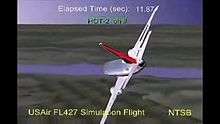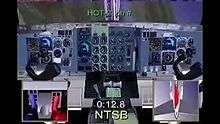USAir Flight 427
.jpg) A USAir Boeing 737-300 similar to the one involved. | |
| Occurrence summary | |
|---|---|
| Date | September 8, 1994 |
| Summary | Rudder hardover[1]:ix |
| Site |
Hopewell Township, Beaver County, Pennsylvania 40°36′14″N 80°18′37″W / 40.60393°N 80.31026°WCoordinates: 40°36′14″N 80°18′37″W / 40.60393°N 80.31026°W |
| Passengers | 127 |
| Crew | 5 |
| Fatalities | 132 (all) |
| Survivors | 0 |
| Aircraft type | Boeing 737-3B7 |
| Operator | USAir |
| Registration | N513AU[2] |
| Flight origin | O'Hare International Airport |
| Stopover | Pittsburgh International Airport |
| Destination | West Palm Beach Int'l Airport |
USAir Flight 427 was a scheduled flight from Chicago's O'Hare International Airport to Pittsburgh International Airport, with a final destination of West Palm Beach, Florida. On Thursday, September 8, 1994, the Boeing 737 flying this route crashed while approaching runway 28R of Pittsburgh International Airport, located in Findlay Township, Allegheny County, Pennsylvania, which at the time was the largest hub for the airline. All 132 people on board the aircraft were killed.[1]:9
Involved
Aircraft
The aircraft involved, a Boeing 737-3B7, registration N513AU, and previously registered as N382AU. The aircraft was powered by two CFM56-3B2 engines and had recorded approximately 16,810 hours of flight time before the crash.[1]:1:6
Crew
Captain Peter Germano, 45, was hired by USAir in February 1981. First Officer Charles B. "Chuck" Emmett III, 38, hired in February 1987 by Piedmont Airlines (which merged into USAir in 1989). Both pilots were regarded as excellent pilots. They were both very experienced, with approximately 12,000 flight hours and 9,119 flight hours respectively. Flight attendants Stanley Canty and April Slater were hired in 1989 by Piedmont Airlines. Flight attendant Sarah Slocum-Hamley was hired in October 1988 by USAir.
Crash

During its arrival into Pittsburgh, Flight 427 was sequenced behind Delta Airlines Flight 1083, a Boeing 727-200. At no time was Flight 427 closer than 4.1 miles to Delta 1083, according to radar data.[1]:2 During the approach, Flight 427 encountered wake turbulence from Delta 1083; the FAA, however, determined "the wake vortex encounter alone would not have caused the continued heading change that occurred after 1903:00."[1]:245 At 7:02:57 p.m., there were three sudden thumps, clicking sounds, and a louder thump, and then the 737 began to bank and roll to the left.[1]:4 The aircraft stalled and rolled upside down. Germano exclaimed "Hold on" numerous times,[1]:138 while Emmett said "Oh shit."[1]:143 Germano exclaimed, "What the hell is this?"[1]:6 As air traffic control noticed Flight 427 descending without permission, Germano keyed the mic and stated, "Four-twenty-seven, emergency!"[1]:6 The aircraft then rolled back upright, but after a few seconds on its side, the aircraft continued to roll while pitched nose-down at the ground. Emmett shouted "What the hell!" and the air traffic controller heard this. In an 80-degree nose-down position, banked 60 degrees left and traveling at 300 mph (480 km/h), the 737 slammed into the ground and exploded at 7:03:25 p.m. in Hopewell Township, Beaver County,[3] near Aliquippa. All 127 passengers and five crew members were killed.[1]:ix The plane just barely missed the Green Garden shopping plaza and the Aliquippa exit of the Beaver Valley Expressway (I-376, then PA-60), which was crowded with commuter traffic. The 737 crashed onto a private gravel driveway and hillside on Pettita Lane in an area protected against trespassing. A memorial has been placed at the site of impact.
At the time of the crash, Flight 427 was the second-deadliest accident involving a Boeing 737 (all series); as of 2012, it was the sixth deadliest. It was also the seventh-deadliest aviation disaster in the history of the United States, and the deadliest in the US involving a 737; as of 2012, it ranks eleventh. The accident marked USAir's fifth crash in the period from 1989 to 1994.[4] Among the victims of the crash was noted neuroethologist Walter Heiligenberg.[5]
After the crash, USAir had difficulty determining Flight 427's passenger list, facing confusion regarding five or six passengers. Several employees of the U.S. Department of Energy had tickets to take later flights, but used them to fly on Flight 427. One young child was not ticketed.[4] As a result of the severity of the crash impact, the bodies of the passengers and crew were severely fragmented, leading investigators to declare the site a biohazard. For the first time in NTSB history, investigators were required to wear full-body biohazard suits while inspecting the accident site.[6]
Investigation

The National Transportation Safety Board investigated the crash. After the longest accident investigation in NTSB history — lasting more than four and a half years — the NTSB released its final report on March 24, 1999.[1][10] The NTSB concluded that the accident was due to mechanical failure:
The National Transportation Safety Board determines that the probable cause of the USAir Flight 427 accident was a loss of control of the airplane resulting from the movement of the rudder surface to its blowdown limit. The rudder surface most likely deflected in a direction opposite to that commanded by the pilots as a result of a jam of the main rudder power control unit servo valve secondary slide to the servo valve housing offset from its neutral position and overtravel of the primary slide.[1]:ix
The exact mechanism of the failure involved the servo valve, which remains dormant and cold for much of the flight at high altitude, seizing after being injected with hot hydraulic fluid that has been in continuous action throughout the plane. This specific condition occurred in fewer than 1% of the lab tests, but perfectly explained all of the successive rudder malfunctions that caused Flight 427 to crash.
The NTSB concluded that similar rudder problems had caused the previously mysterious March 3, 1991 crash of United Airlines Flight 585 and the June 9, 1996 incident involving Eastwind Airlines Flight 517, both Boeing 737s.[1]:292–295
Aftermath
USAir submitted to the NTSB that pilots should receive training with regard to a plane's crossover speed and recovery from full rudder deflection,[7] As a result, pilots were warned of and trained how to deal with insufficient aileron authority at an airspeed at or less than 190 knots (352 km/h), formerly the usual approach speed for a Boeing 737. Four additional channels of information — pilot rudder pedal commands — were incorporated into flight data recorders.
Boeing maintained that the most likely cause of the crash was that the co-pilot inadvertently deflected the rudder hard-over in the wrong direction while in a panic and for unknown reasons maintained this input until impact with the ground.[1]:96–100[11] According to aviation law firm Katzman, Lampert, and McClune, which represented families and victims of both US Air 427 and United 585, Boeing did not contest in open court that its 737's rudder was prone to an uncommanded rudder issue while in flight.[12] Nonetheless, Boeing agreed to redesign the rudder control system with a redundant backup and paid for the retrofit of the entire worldwide 737 fleet. In 2015, former investigator John Cox stated that time so far has proven the NTSB correct in their findings due to the absence of a rudder reversal incident since Boeing's redesign.
Following the airline's response to the Flight 427 accident, the United States Congress required airlines to deal more sensitively with the families of crash victims.[13] and US Airways ceased using Flight 427 as a valid flight number. Flight 427 was the second fatal USAir crash in just over two months, the other being Flight 1016 at Charlotte-Douglas Airport in July 1994. The crashes contributed to the financial crisis USAir was experiencing at the time.[14]
In popular culture
The Discovery Channel Canada / National Geographic TV series Mayday (also called Air Crash Investigation or Air Disasters) dramatized the crash of Flight 427 and the NTSB's 737 rudder investigation in a 2007 episode titled Hidden Danger (broadcast in some countries as Mystery Crashes).[6]
See also
- Boeing 737 rudder issues
- United Airlines Flight 585
- Eastwind Airlines Flight 517
- American Airlines Flight 1
- Northwest Airlines Flight 85
References
- 1 2 3 4 5 6 7 8 9 10 11 12 13 14 15 Aircraft Accident Report - Uncontrolled Descent and Collision With Terrain, USAir Flight 427, Boeing 737-300, N513AU, Near Aliquippa, Pennsylvania, September 8, 1994 (PDF). National Transportation Safety Board. March 24, 1999.
- ↑ "FAA Registry". Federal Aviation Administration.
- ↑ "28 Seconds of Horror," Pittsburgh Tribune-Review
- 1 2 "28 Seconds: The Mystery of USAir Flight 427 Part One: Zulu." 4. Retrieved on December 31, 2012.
- ↑ "List of Crash Victims." Wilmington Morning Star. September 10, 1994. 4A. Google News (28 of 49). Retrieved on October 3, 2009.
- 1 2 "Hidden Danger". Mayday. Season 4. 2007. Discovery Channel Canada / National Geographic Channel.
- 1 2 Bertorelli, Paul (1997-10-19). "USAir 427: US Airways' View of the Accident - AVweb Features Article". Avweb.com. Retrieved 2016-12-03.
- ↑ "28 Seconds: Roxie, Trixie and the fat guy 3". Sptimes.com. 1994-09-08. Retrieved 2016-12-03.
- ↑ Federal Aviation Administration (1994-09-08). "Lessons Learned". Lessonslearned.faa.gov. Retrieved 2016-12-03.
- ↑ NTSB Office of Public Affairs (March 24, 1999). "NTSB Concludes Longest Investigation in History; Finds Rudder Reversal was Likely Cause of USAIR Flight 427, A Boeing 737, Near Pittsburgh in 1994" (Press release). National Transportation Safety Board. Retrieved July 18, 2016.
- ↑ October 29, 1996 (1996-10-29). "The Seattle Times: Safety at issue: the 737". Old.seattletimes.com. Retrieved 2016-12-03.
- ↑ Katzman Lampert & McClune "US Air 427 crash Near Pittsburgh, Pennsylvania."
- ↑ Remarks from acting NTSB Chairman, 2002
- ↑ Halvonik, Steve. "Disaster only one in a string of setbacks for troubled company." Pittsburgh Tribune-Review. Sunday September 5, 2004. Retrieved on January 1, 2012.
External links
- www.airliners.net - picture of N513AU painted in USAir's brown, orange, and red livery
- NTSB Accident Investigation Docket (Archive)
- AVweb article
- AVweb supplement
- Accident description at the Aviation Safety Network
- 28 Seconds Four-part article from the Saint Petersburg Times
- Boeing 737 Rudder Design Defect
- "Remembering Flight 427." Pittsburgh Tribune-Review. (Archive)
- Pre-Crash accident photos from Airliners.net
- Schaarsmith, Amy McConnell. "Mourners remember at 15th anniversary." Pittsburgh Post-Gazette. September 9, 2009.
- Memorial location
Books
- Bill Adair, The Mystery of Flight 427: Inside a Crash Investigation, ISBN 1-58834-005-8
- Gerry Byrne, Flight 427: Anatomy of an Air Disaster, ISBN 0-387-95256-X